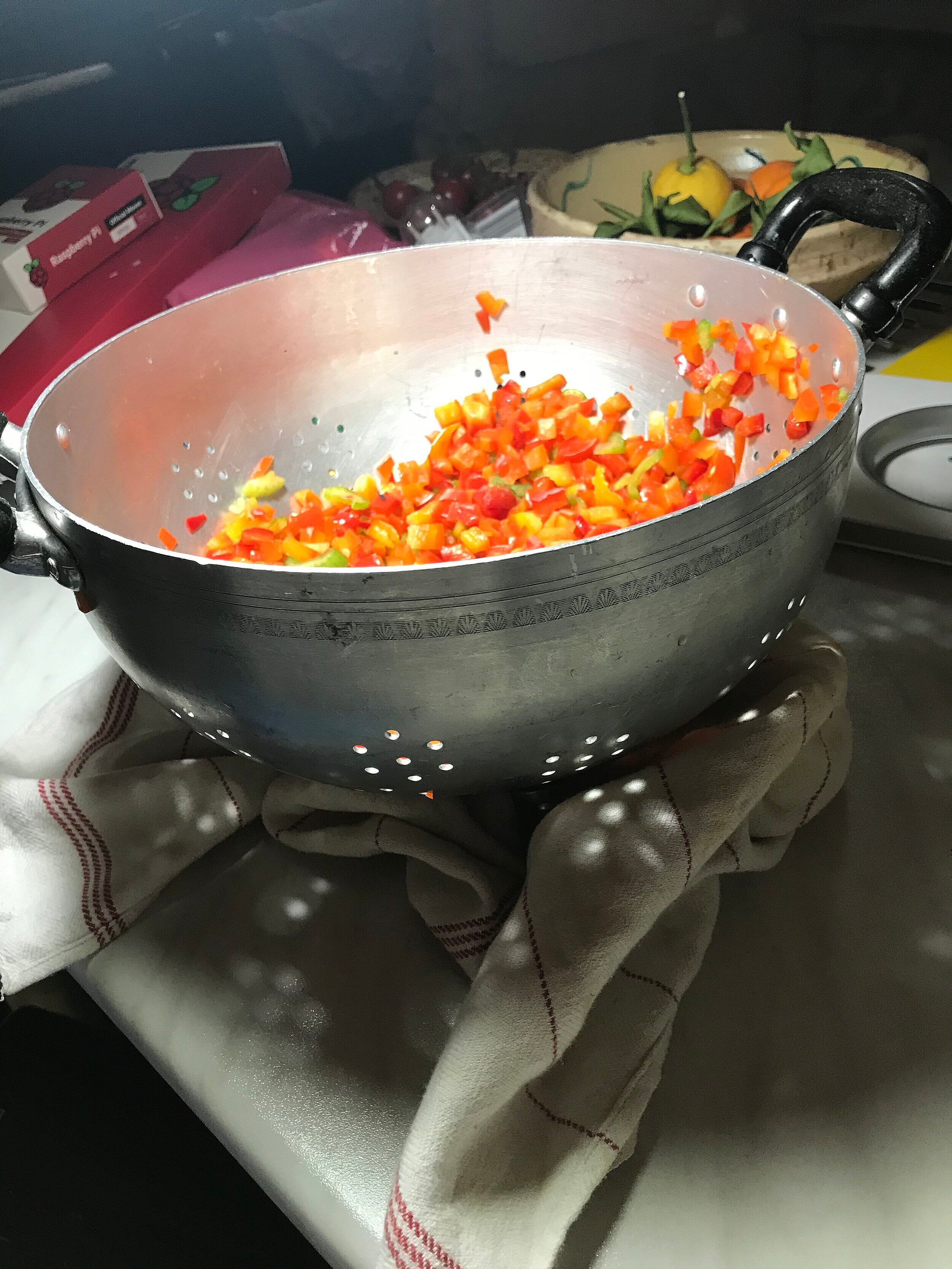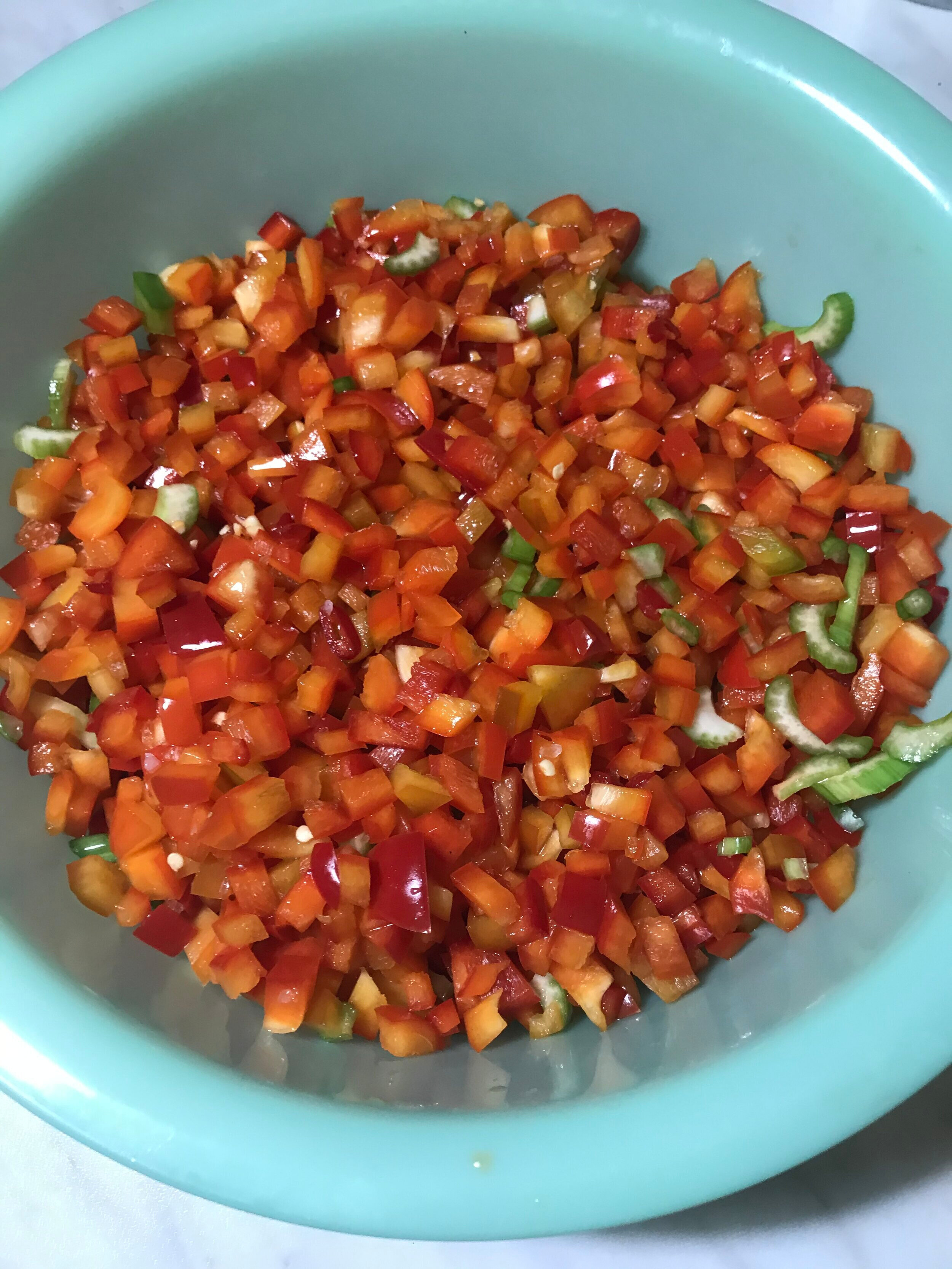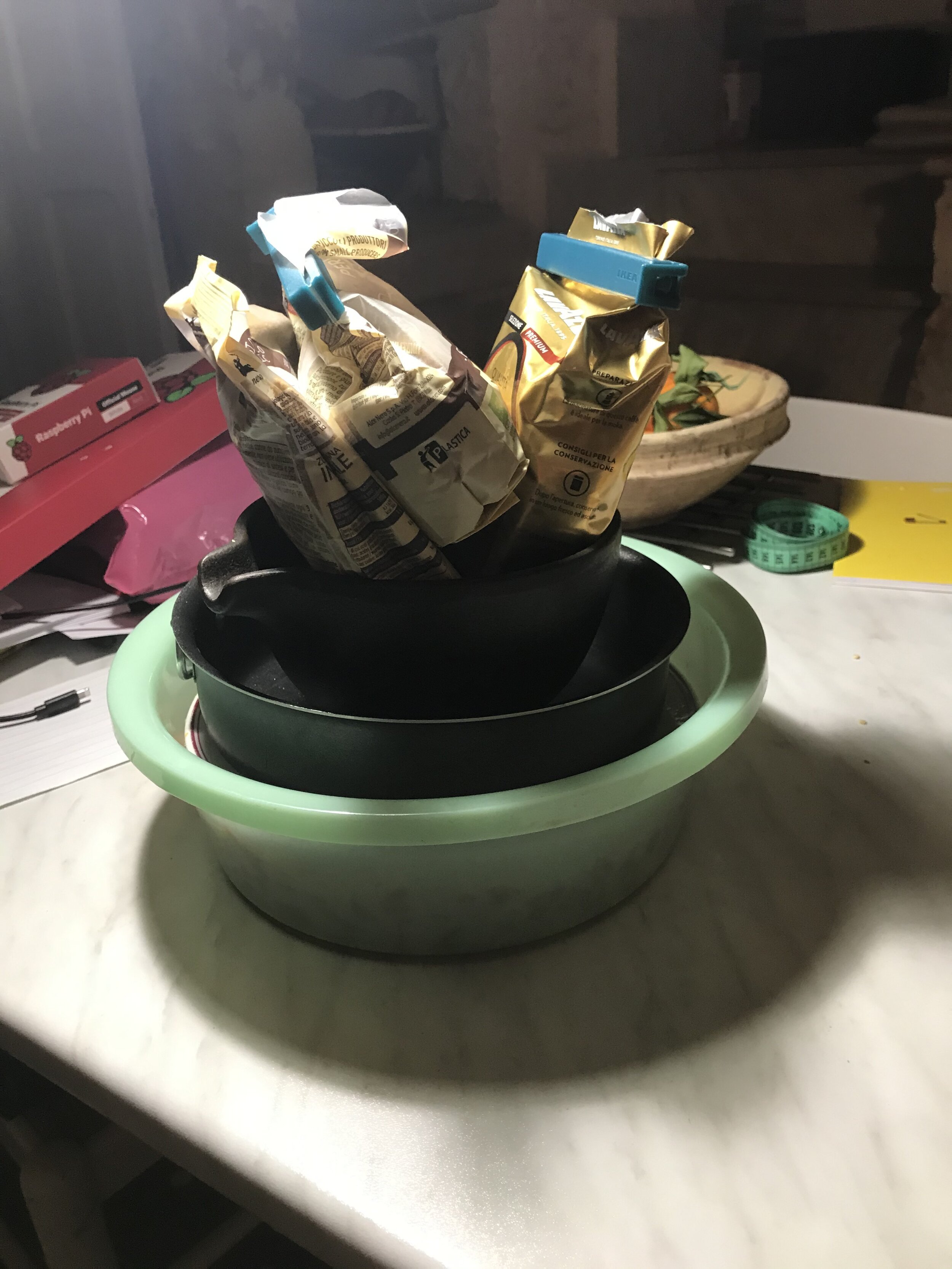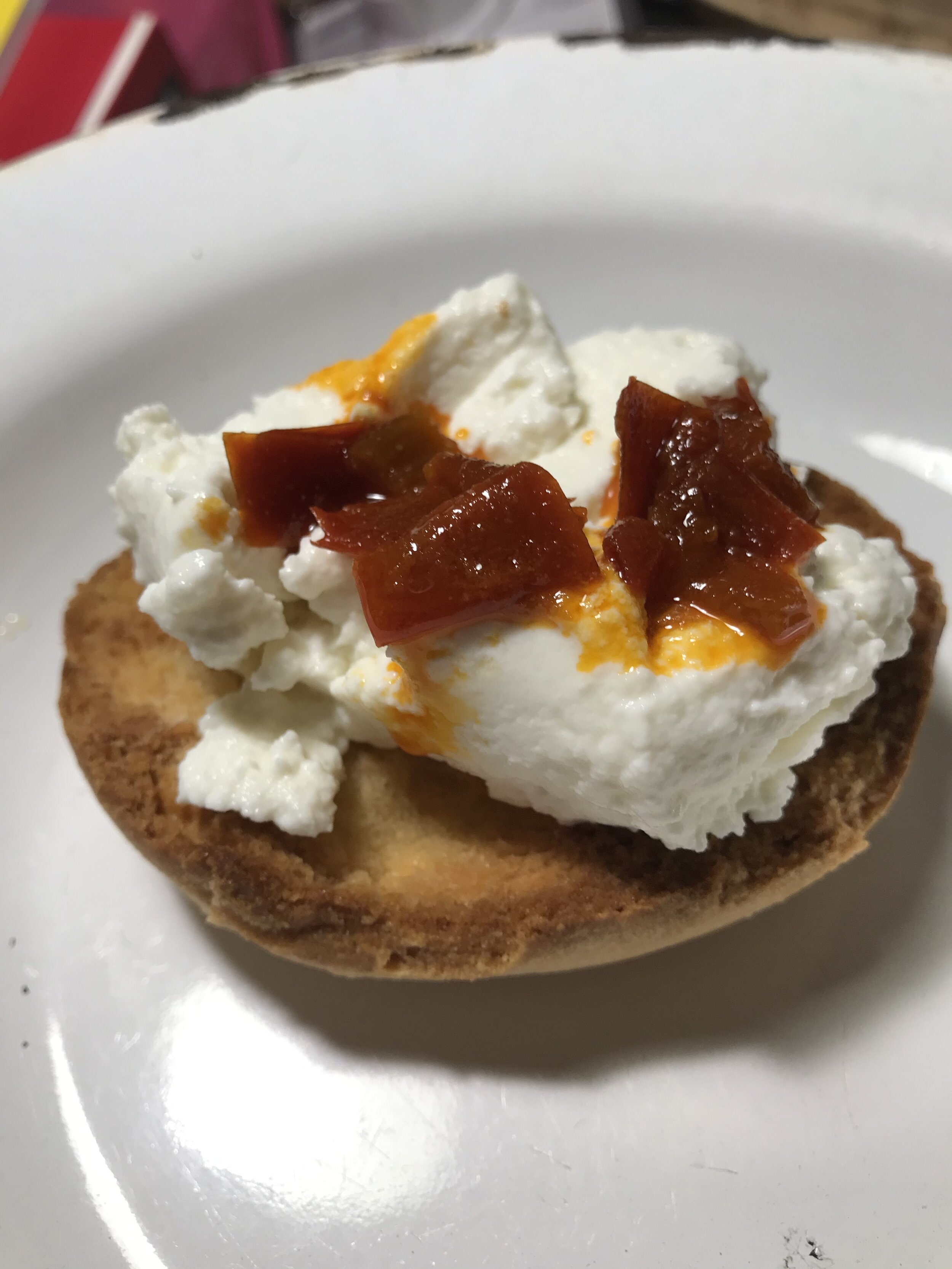Puglian Red Pepper Relishes: Pipone and Plic e Plac
A jar of Pipone, waiting to be shelved in the cupboard, or eaten straight away
It’s a midwinter Sunday night and it has been raining a torrent all day. The streets of Ceglie are empty, but that’s possibly because everyone seems to be crowded into this café. It’s a big match tonight, Napoli v. Juventus. I’ve been shunted from my favourite table to a darkish corner with no view of the screen, which is fine by me. The roar of delight as Napoli scored the only goal so far was deafening.
I love to watch il tutto Ceglie in their social element, and in an unexpected way it has made me think of summer Sunday evenings, when the streets are thronged, and so of peppers and chillis. Red peppers, curving and twisting and glossy and of the posies of fiery fresh red chillis at the market and Olivia and Roberto’s green grocer’s shop round the corner.
As in any supermarket, peppers are available all year round these days, but in the summer their scarlet plumpness, and caressable curves make them the starlets of any stall. And the summer heat deepens the sweetness and flavor while abundance batters down the price. Every third or fourth person at the market is bearing a crate or two of peperoni, taking them home to grill, to stew, to roast, to stuff, and above all to preserve for a winter night like tonight.
Here in Puglia, every town seems to have its own particular way of preserving peppers. They are, by and large, variants of the same thing. The ingredients lists will include, besides the peppers themselves, extra virgin olive oil (of course), garlic, fresh, dried or ground peperoncini (chillis), salt and some or all or none of the following: celery, tomatoes, capers, mint, basil, oregano.
Like the relishes themselves, the familiar names vary from one town to another. Maria, my next-door neighbour (born here, but brought up in Taranto) makes Pipone whilst the inhabitants of Martina Franca, all of 11 miles away, make Plic e Plac, very similar but with a little tomato added for acidity and sauciness.
Peperonata, another more familiar name, is recognised across the region, but had me mightily confused as I think of it as a freshly cooked side dish. I’ve long prided myself on making excellent peperonata, frying strips of pepper, with onions, garlic, a modicum of tomato, and a seasoning of fennel seeds. Delicious hot, warm or at room temperature, with a roast chicken, or steak, or piled on bruschetta with scoops of fresh ricotta and sprigs of basil. Further reading and scouting and I now understand that here in Puglia, and possibly throughout Italy, peperonata just refers to any delicious mess of cooked peppers. Eat it now, eat it in 6 months’ time, tomatoes or no tomatoes, onions or no onions, capers or no capers, it’s still peperonata.
The best of all of the local pepper conserves has to be Maria’s Pipone (that’s it in the jar at the top of the page), cooked slowly in the cooling embers of the wood-fired oven out at her olivetta, her olive orchard. The oil she uses, naturally, was pressed from the fruit of these trees a little less than a year ago. It’s a two-day process and it goes something like this:
Maria and her bread oven
Saturday Morning early – she heads off to the market to buy her ingredients – 7 kilos of red cornaletti peppers, a head of celery, a bunch of fresh red chillis, garlic. E basta (enough).
Saturday Afternoon – chopping, deseeding, chopping, deseeding, chopping, deseeding. Da sola, single-handedly (I was out when she called to see if I’d like to help), all 7 kilos of peppers, the chillis and celery and garlic
Saturday, early evening – hands reddened from chilli and garlic (she left her plastic gloves at home). In a blue plastic bucket, she mixes the vegetables with plenty of salt to draw out the excess moisture. A large plate or saucepan lid slidden, no, slid, or even slided or none of the above, on top and weighted down with another bucket filled and heavy with water. The peppers are finally ready for bed, as is Maria.
Sunday, early morning. At her ulivetta, two hefty bundles of almond and olive prunings are stacked by the bread oven. We heft one and a half bundles of sticks into the oven, and soon the flames are flickering. The vegetables are swilling with scarlet water. She slides them into a big colander to drain and then she squeezes out the last few rosy drops.
An hour or so later the embers glow white hot. Maria piles the peppers, shrunken to a quarter of their original volume into a wide, deep roasting tin and slakes them with good olive oil. She protects them from ash with sheets of foil and pushes the tray into the dancing heat.
Sunday, mid-day – the meshed scents of woodsmoke and caramelising peppers is intoxicating. From the fields a faint seasoning of pine on the air. Maria pulls the tray of peppers from the oven. She settles to the final task, quick and repetitive, filling a host of small jars and sealing them tight.
Sunday, early afternoon – back at home the jars are heat-processed for 30 minutes in a capacious pan of simmering water.
36 hours in the making, the jars are finally ready to be tucked away on the shelves, waiting to light up winter meals. All bar one.
Postscript: Sunday, early evening: Downstairs in Maria’s kitchen, half a jar of pipone is tossed straight into hot pasta, with butter, flaked tuna and capers. Upstairs in my kitchen, the other half is tossed straight into hot pasta with rocket and the last of the gorgonzola.
Ingredient Notes:
Cooks, books and blogs suggest that these Puglian pepper relishes should be made with cornaletti, (little horns) or corno di bue or corno di toro (bull’s horn) sweet peppers which are fittingly long and tapering, glossily red like a bull’s horns in battle. They are thinner-walled, and less juicy than the classic red bell pepper, which has the advantage of reducing salting and cooking times. Despite the warnings, I’ve made both Pipone and Plic e Plac with the common sweet red peppers and they work just fine, even if not so authentic.
Puglian chillis are fairly ferocious. Two are quite enough to give the relish a decent chilli bite, but with milder British red supermarket chillis (the standard, medium-sized cone-shaped ones), I’d recommend boldly popping four of them into the mix.
Corno di Bue Peppers
Methods:
You don’t need to have a wood-fired bread oven to make either of these relishes, lovely though the extra smoky note is. Actually, you don’t need an oven at all. Both Pipone and Plic e Plac can be cooked either in the oven, or on the stove top. For the latter you will need a thick-bottomed sturdy pan to reduce the chance of catching and burning on the base. These two methods are interchangeable. Your choice.
PIPONE (roasted in a domestic oven)
Makes 2 x 250 ml jars
Around 750g red peppers
2-4 fresh red chillis
1 chunky stem celery
2 cloves garlic, chopped
200 ml extra virgin olive oil
20g salt
Part 1.
Quarter the red peppers, remove seeds and stalk and white membrane. Dice into little pieces around 1 cm square. Snip or chop the red chillis into small rings. Remove seeds if you want to. Cut the celery in half lengthways, then slice thinly. Mix these three in a bowl with the salt. Tip into a colander set over a bowl. Find a plate that will fit inside the colander, not too tightly, slide it in, then put a heavy weight on top. I used my cast iron mortar, but tins of tomatoes or whatever you have to hand will do just fine. Transfer the peppers to the fridge, and leave to drain for 12 hours or overnight, mixing them up once or twice during that time, so that they are fairly evenly pressed.
Part 2. Oven cooking method
Maria’s finished Pipone
Pre-heat the oven to 150C/Fan 130C/Gas Mark 2. Use your hands to squeeze out the last drops of moisture from the peppers then tip them into a roasting tin or wide oven-proof casserole. Add the oil. Stir, then cover with foil and slide into the oven. Cook gently for 2 hours, stirring after an hour.
Now discard the foil, stir again and slide back into the oven. Cook for another half an hour. By now the peppers will have shrunken and lost virtually all their residual moisture, darkening to a deep brick red. Cool slightly.
Part 3.
Ladle into sterilized jam jars, leaving a good 1 cm empty at the top. Seal tightly. Either store in the fridge, or water-process them for long term storage (not half as complicated as you might imagine).
PLIC E PLAC (stove-top method)
Red Pepper Relish from Martina Franca
Next door town, Martina Franca’s version of red pepper relish includes just a small amount of tomato. To see how it’s made, take a look at local cook Micli’s video here . It’s in Italian, but the method is clear. She starts with 5 kilos of peppers, but my recipe is for a beginner’s haul, i.e. a mere 1 kilo.
Enough for 2-3 x 250ml jars
1 kilo red peppers, deseeded and diced
2-4 red chillis
1 stem celery
25g salt
2 cloves garlic, peeled and smashed lightly
2 medium tomatoes (around 150g), skinned and deseeded
250 ml extra virgin olive oil
Part 1
Prepare and salt the peppers, celery and chilli as for Pipone. Leave to drain for 12 hours. Dice the tomatoes.
Part 2. Stove Top Method
Pour the oil into a heavy-based saucepan or heat-proof casserole. Squeeze a few more drops of moisture from the peppers, and add them too. Stir and cook, uncovered over a gentle heat for 1 ½-2 hours, stirring occasionally to prevent sticking. After this long, long stewing in oil, peppers and tomatoes will have lost their moisture, and be melting down and almost jammy. Turn off the heat and stir them vigorously with a wooden spoon to create a chunky, oily mush.
Part 3.
Now it’s ready to pot up in sterilized jars. As with Pipone, store in the fridge or process in boiling water for 30 minutes if you want to keep it for the winter months.
Enjoyed this recipe? browse more classic Puglian recipes in the recipes category.
Follow on Instagram, Twitter or Facebook for regular updates, or subscribe to my newsletter.










